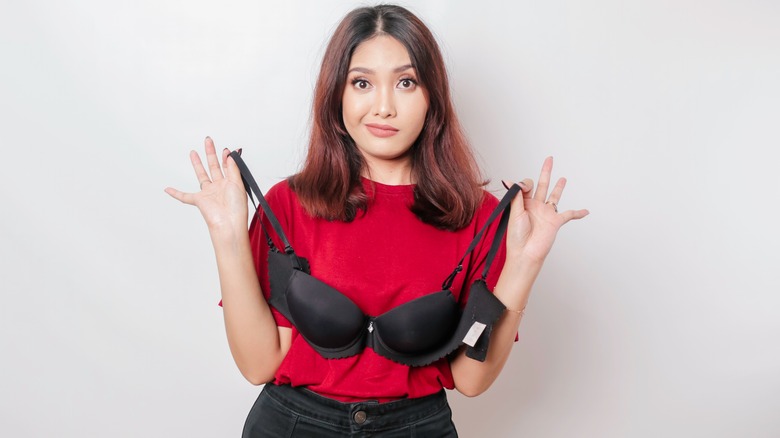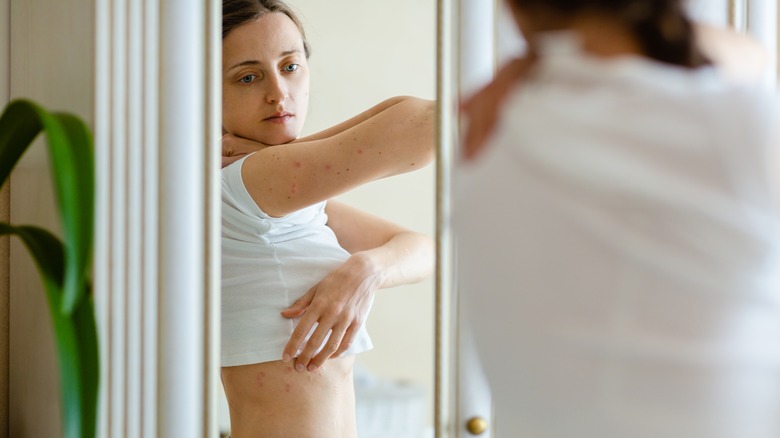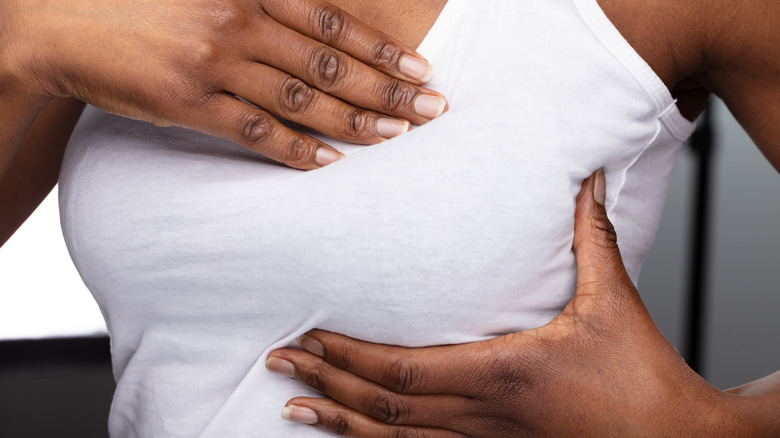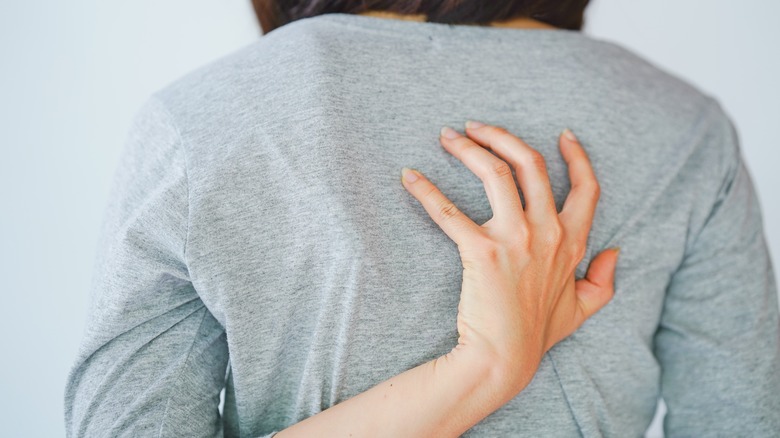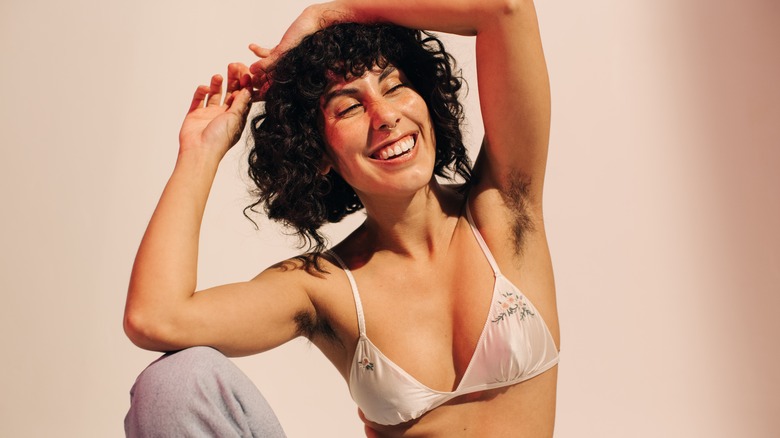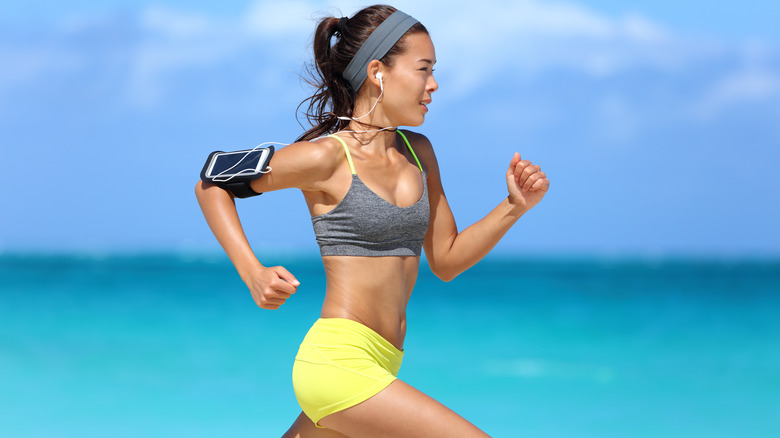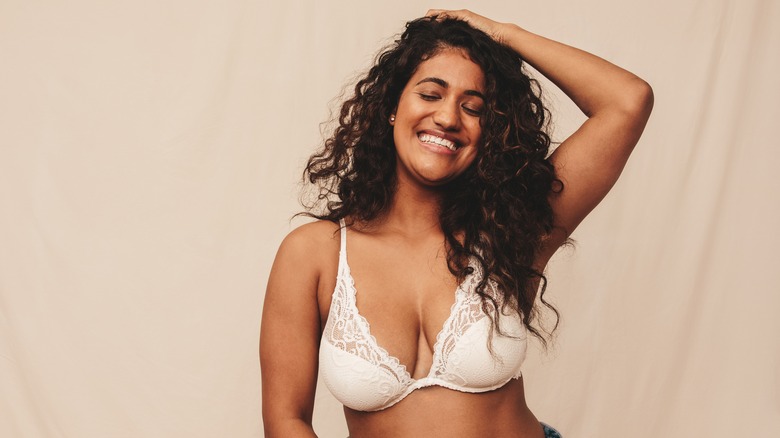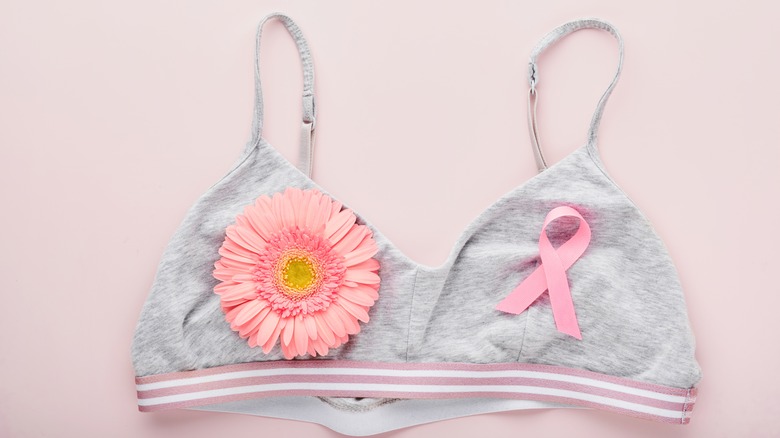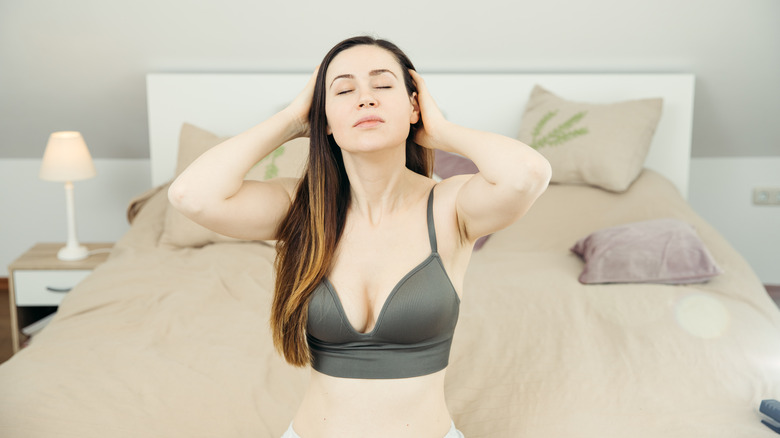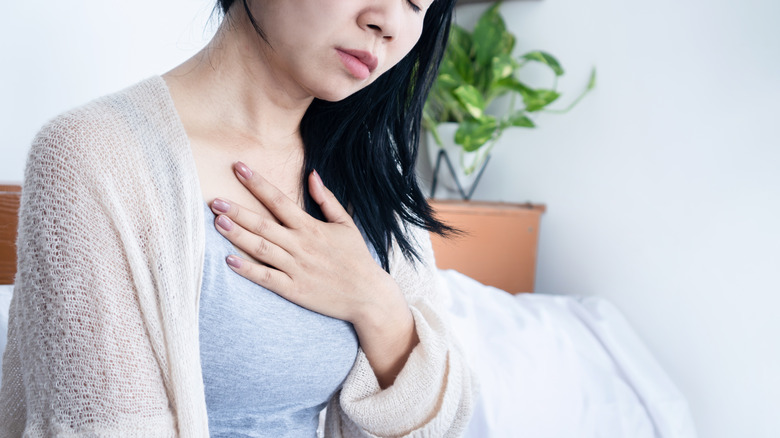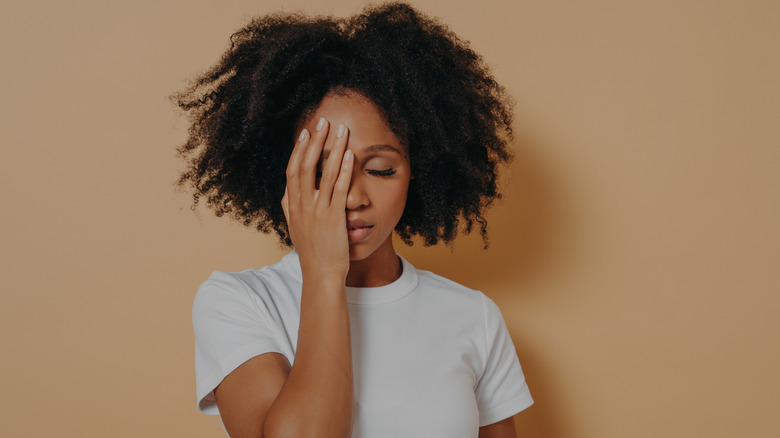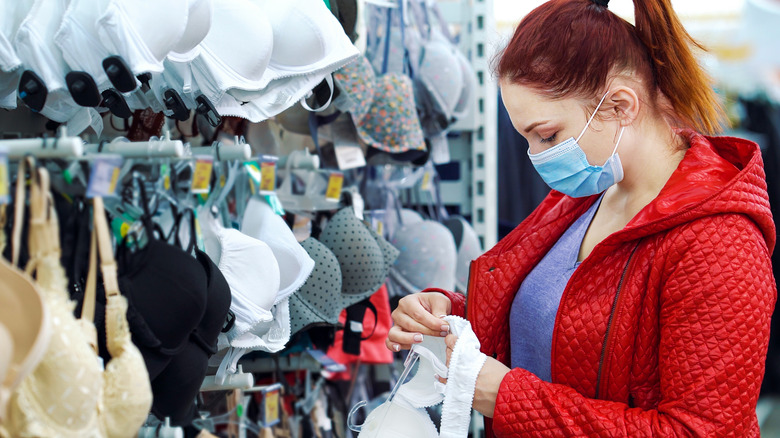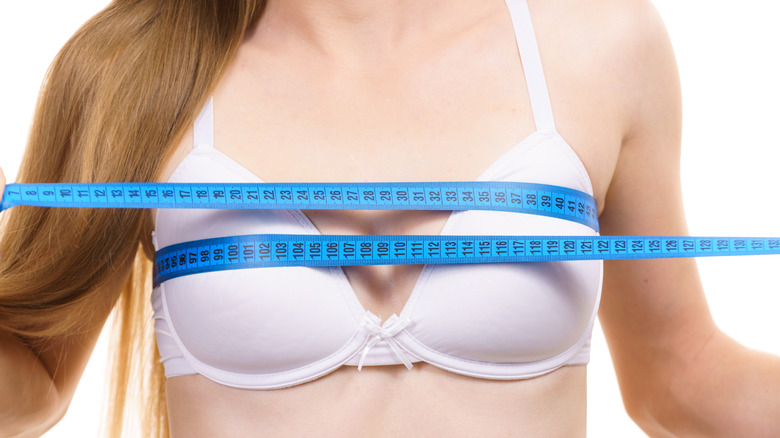The Surprising Side Effects Of Wearing A Bra
Bras have been around for a really long time. It is believed that this garment originated in ancient Greece, according to NPR. It didn't exactly look like it does today, however. The first bras were likely wool or linen cut in bands that were then wrapped around women's breasts. It was kept in place by tying or pinning the wool or linen at the back. Corsets soon replaced these simple bras, and women had to fight for every breath of air until corsets went out of fashion at the end of World War I in 1918. In 1914, a woman named Caresse Crosby experimented with what would become the first modern bra in the United States. It consisted of a pink ribbon and two pocket handkerchiefs. This design inspired bras as we know them today.
Many of us can't imagine our lives without this ancient piece of lingerie, but the effect this garment has on our bodies is undeniable. Speaking to Elle, osteopath Robin Lansman explained that bras fulfill an important function: They act as support for the structure and weight of the breasts. While this garment does a whole lot of good, it can impact your body in various ways. Read on to discover what happens to your body when you wear a bra.
Bras can contribute to fungal infections and even body acne
When you think of bras and hot summer days, two words likely come to mind: boob sweat. This can lead to some unwanted conditions, like yeast and fungal infections.
"You want to be mindful of how you position your breasts in a bra, particularly during warmer months," says Dr. Cassann Blake, breast health specialist (via the Cleveland Clinic). "When you wear a larger cup size, skin rubbing can occur along the inframammary fold (the area under the breast crease)." The combination of sweat and friction creates the perfect environment for fungal infections to thrive. Blake says to ensure you position your breasts in the cups in a way that prevents any friction. To play it extra safe, spray some of your everyday deodorant between and beneath your breasts to fight sweat. Cornstarch is also a great option. In some cases, opting for a bra without an underwire can help ease irritation as well.
Something else that's incredibly important is making sure you don't wear the same bra twice in a row without washing it. The buildup of bacteria, sweat, and dirt is a playground for fungal infections and can even cause body acne to develop, according to Dr. Melissa Doft, cosmetic plastic surgeon (per Refinery29). However, for those with bigger breasts, wearing a bra every day can actually help prevent body acne from developing because the bra acts as a barrier between skin folds, notes Dr. Constance M. Chen, board-certified plastic surgeon.
You might deal with skin irritation and inflammation
If wearing a bra every day seems to be making your skin very angry, you're not alone. "When tight clothing rubs the skin, it can cause excess sweating as well as irritation and inflammation of hair follicles. Not only that, bacteria and/or fungus on the surface of the skin can more easily penetrate into these hair follicles, causing infection" says Dr. Heather Downes, board-certified dermatologist (via Healthline).
If you've been dealing with various skin issues around your breast area, you now know why. Tight bras can put you at a higher risk of developing painful skin issues like heat rash, hives, dermatitis, and folliculitis. Heat rash tends to develop when your skin's sweat ducts become plugged. Hives are a result of continuous pressure on the skin (like from a super tight bra). Dermatitis, which is an umbrella term used to refer to various types of skin inflammation, typically manifests as discolored, swollen, and dry skin (per Healthline). This can be incredibly uncomfortable and painful, and in some cases require medical treatment, especially if it spreads or doesn't improve.
Folliculitis refers to inflammation of the hair follicles on the skin caused by bacteria. If you notice pimple-like bumps around your breast area that are painful and itchy, you're likely dealing with this condition. It can spread to the rest of the body if not treated, and can eventually progress from pimple-like bumps to "crusty sores" (via the Mayo Clinic).
You might experience back and shoulder pain
Wearing a bra every day might be the reason you're dealing with nagging back and shoulder pain. "The most common bra fit issue is a cup that's too small and a band that's too loose," says Robynne Winchester, owner of lingerie chain Revelation in Fit (per Healthline). "This results in a bra that is unsupportive, uncomfortable, and leads to issues such as shoulder and back pain."
Medical News Today warns that tightening the shoulder straps too much over a prolonged period of time can even cause permanent grooves to develop in your shoulder's soft tissues — yikes! "What I see ... in my practice are tight bra straps that rub on benign skin lesions such as seborrheic keratoses and moles. These lesions can then swell or bleed and can feel painful," says Dr. Heather Downes, board-certified dermatologist (via Healthline).
Winchester says that people often tighten their bra straps because the bra's band is too loose. This means you're not wearing the right fit and putting unneeded pressure on your shoulders. An ill-fitting bra can also lead to aches and pains in the chest muscles and neck. If your bra is causing any of these symptoms, it's time to go for a professional fitting. The right size will make a world of a difference.
A good bra can help reduce strain on the back, neck, and shoulders
We've established that ill-fitting bras can cause a myriad of problems in the upper body. Osteopath Robin Lansman told Elle that tight-fitting bras can not only negatively affect your back and neck but can also have a significant impact on your ribcage's ability to expand. A bra that fits right, however, can usually solve all of these problems by easing any strain the back, neck, and shoulders experience on a daily basis.
Also speaking to Elle, Carole Remy, communication manager for bra company Empreinte, says that the right bra will provide you with all-around comfort, which can help eliminate back pain. She added that, even when you simply walk throughout the day, your breasts move around three to four centimeters. When you're working out, these numbers go up. "A breast can weigh more than a kilo when you are a D cup or above. The pressure on the whole body is huge, especially for the back," she explains, adding, "Remember that breasts are made up of fat, glandular and adipose tissues, and only the skin and the ligaments support them."
Wearing a decent bra takes the pressure off your breasts and the rest of your body and can help ease lingering aches and pains. According to Medical News Today, a well-fitting bra can even lead to better posture as well. The improvement in posture then helps to ease back pain. This is especially true for people who have larger breasts.
Your breathing might be affected
Because part of a bra rests on the ribcage, it makes sense that it can affect your breathing, and if this is the case, it's time to investigate — there's a reason women no longer tolerate corsets, after all.
There's a fine line between a bra that fits snugly and a bra that's simply too tight. This can be especially tough to gauge with sports bras, which by their very nature are tighter to accommodate high-impact movement. But if you struggle to take a deep breath, it's a sure sign that you need to make a change. Speaking to How Stuff Works, director of the women's sports medicine program at Johns Hopkins University, Dr. Miho Jean Tanaka explains that not being able to breathe properly (especially while working out) is not a good thing.
Dr. Tanaka says, "[T]his can theoretically be detrimental if it [the bra] constricts to the point of not allowing the chest cavity to expand during breathing. As most sports bras are designed with elastic bands, it would be unusual for this to actually impair breathing to the point of being dangerous, but could lead to discomfort." However, Dr. Tanaka warns that you shouldn't go too hard if you do notice that you're struggling to catch your breath, especially if you're a runner. Your body heavily depends on sufficient breathing during exercise, and if you start to feel light-headed or experience shortness of breath, it's time to stop what you're doing and invest in a bra that fits right.
The same goes for everyday bras. Speaking to Refinery29, Dr. Melissa Doft, cosmetic plastic surgeon Melissa Doft, explains that some people find underwire bras to be too tight, especially when they think they're wearing the right size but aren't. If you're trying to take some deep breaths in between work calls but find that it's taking a lot of effort, it's time to lose the bra you're wearing.
Sports bras can reduce breast pain during exercise
Anyone who's ever done any kind of high-impact exercise without a decent bra knows just how painful it can be, especially if your breasts are on the larger side. "Purchase a bra with the right amount of support for the activity you're doing," Dr. Cassann Blake, breast health specialist, told the Cleveland Clinic. "You might not want to wear a sports bra with a lot of support while you're binge-watching TV. But if you're running, get a bra with better support, especially if you wear a larger cup size."
Blake adds that women shouldn't underestimate the power of a good sports bra — it helps to minimize the movement of your breasts during high-impact exercises and in doing so you won't experience breast or even back pain. Studies support Blake's claims. A 1999 study published in the Journal of Science and Medicine in Sport found that it's incredibly common for women to experience some form of breast pain when they exercise — in fact, up to 56% of participants in surveys used for the study said that they experience breast pain while working out. The study found that wearing a bra provides efficient support and helps to minimize the up-and-down movement of breasts while exercising. Sports bras were found to be the most effective when it came to minimizing breast movement during vigorous activity. The study recommends women wear fitted sports bras to ensure their breasts stay comfortable during exercise.
Bras could possibly restrict the growth of breast tissue, causing sagging
Whether or not bras can cause sagging of the breasts is still a hot topic of debate among medical professionals.
A few years ago, sports medicine specialist, professor Jean-Denis Rouillon, revealed that he'd been conducting research on the effect bras have on women's breasts for 15 years. He found that "medically, physiologically and anatomically," there's no benefit to wearing a bra every day (via The Connexion). He added that bras are a "false 'need'" and that forgoing one could actually help the breasts lift, saying that women's nipples could lift by as much as 7 millimeters in a year's time if they stopped wearing a bra. He explained that his research (which included more than 300 women) showed that ditching this garment can encourage more muscle tissue to grow around the breast, which can perform the same function as a bra (via HuffPost). He did, however, add that not all women will benefit from throwing out their bras and that the study has not been able to evaluate every single breast size.
Medical News Today notes that Rouillon's study was never peer-reviewed, so it's hard to say how accurate his findings are. The outlet adds that there isn't enough research to prove that bras cause or prevent sagging. However, those with larger breasts might actually prevent sagging by wearing a bra simply because it provides much-needed support to the breasts' connective tissue.
Wearing a too-tight bra could possibly increase your breast cancer risk
According to the American Cancer Society, there's no scientific proof that bras can increase women's risk of developing breast cancer. They cite a 2014 study published in Cancer Epidemiology Biomarkers & Prevention that aimed to find a correlation between wearing a bra and breast cancer. Out of the 1,513 postmenopausal women who participated in the study, no link between wearing a bra and developing breast cancer could be found. Per Medical News Today, it's likely that obesity plays a bigger role than wearing a bra. Obese women tend to wear bras more frequently than their peers, and they're also more susceptible to cancer because they're obese.
However, a 2016 study published in the Journal of Oncology Research and Treatment found a link between wearing a tight bra daily and an increased risk of breast cancer. The study also found that women who develop breast cancer frequently report that they sleep with a bra, whereas healthy individuals do not. This study's participants included both pre-and post-menopausal women. Researchers concluded that the tightness of the bra, as well as the number of hours it is worn daily, can have an impact on a person's breast cancer risk.
Wearing a bra at night could negatively impact your sleep cycle
Wearing a bra daily sure has its perks, but is sleeping in it a good idea? According to a small 2000 study published in The Journal of Biological and Medical Rhythm Research, it might not be.
The study, which consisted of 10 participants, found that tight-fitting clothing like bras has a significant impact on melatonin production and body temperature while people sleep. Researchers found that participants experienced decreased melatonin production and increased body temperature when wearing tight-fitting clothing to bed. This has an effect on the sleep-wake cycle and can lead to decreased sleep quality. Medical News Today notes that more similar research needs to be conducted to support this study's findings, but it's safe to say that going to bed braless is likely a good idea.
If sleeping without a bra is incredibly uncomfortable for you, consider opting for a wireless one, bra-fitting specialist Jasmine Jones told Healthline. "Make sure it's a good fit so that it sits just as well as your day bra," she adds. A bra that's a little looser than what you wear daily should do the trick. Make sure that it's pretty flexible and soft as well.
You might experience acid reflux
If you're having some gut issues like acid reflux, your bra might be to blame. Yes, really. Wearing a bra (every day) that's too tight can place a lot of pressure on your midsection, especially a tight sports bra, according to the Maryland Surgery Center. They recommend you buy a bigger size if you notice that your sports bra hugs your ribcage a little too affectionately.
"Tight clothing, such as Spanx, on the abdomen can increase intra-abdominal pressure to the point that one can experience acid reflux from acid being pushed from the stomach into the lower esophagus," says Dr. Heather Downes (via Healthline). If you notice your acid reflux getting worse or start experiencing it for the first time after you start wearing a new bra, there's a good chance that it's the culprit.
Speaking to the Daily Mail, Richard Moore, consultant osteopath and sports massage therapist, explains that ill-fitting bras can cause more than just acid reflux. "All these slight but continuous maladjustments put unnecessary pressure on the diaphragm, which if you are sitting at a desk for hours each day, affect the breathing mechanism and can also be a direct link to digestion problems and Irritable Bowel Syndrome (IBS)." Who knew?
You might deal with nagging headaches
According to WebMD, your bra might be the reason you're experiencing constant, nagging headaches. When a bra doesn't fit right, it can cause unnecessary tension to build up in the muscles of your upper body, which can eventually creep up toward your head. "Headaches can be triggered by bras which are either too tight or too loose, but more often they are caused by looser fits," bra fitting specialist Paula Svoboda told the Daily Mail. Additionally, Svoboda says that you might experience continued neck strain and back pain.
"As soon as the neck muscles become overworked, you are far more likely to get headaches (known as cervicogenic headaches, or neck in origin headaches)," Tim Allardyce, Surrey Physio, told BT (via Cosmopolitan). He adds that a decent, well-fitting bra will most definitely not cause headaches. Instead, it'll help protect the muscles surrounding your breasts and keep your breast tissue strong.
Some bra fabrics can be harmful to your body
You might not think about this when you're busy shopping for new bras, but the fabric the garment is made of is incredibly important. Speaking to Choc & Juice, Sydney Ross Singer, director of the Institute for the Study of Culturogenic Disease, explains that the fabric some bras are made of can actually be toxic to your body.
"There are fabrics that are toxic because of their components, and there are fabrics that are made toxic by what is added to them," Singer says. "Synthetic fabrics, such as nylon and polyester, are polymers made in the laboratory and can break down into their toxic building blocks." He continues to explain that some bras can expose you to 1,3-butadiene, which is a known carcinogen. This compound forms when polymers, like the elastic used in some bras, start to break down.
Singer also warns that other toxins like formaldehyde, petrochemical dyes, fabric softeners, and detergents that are present in the fabric can mix with your sweat and then be absorbed into your skin. This is less than ideal. "I would recommend natural fibers, such as cotton, bamboo, or silk," Singer adds.
Keep your body happy by going for regular fittings
We've established that the bra you wear can have a significant impact on your body, but you can reduce the negative effects it can potentially have and reap all the benefits instead if you buy the right size. In order to do that, you either need to go for regular professional fittings or know what to look for in a good fit so you know you're buying a bra that's right for your body.
Paula Svoboda, bra fitting specialist, told the Daily Mail that the first thing you need to pay attention to when putting on a bra is its 'diaphragm.' "The support comes from the diaphragm of a bra. If your shoulder straps fall down during the course of the day, it's a sign that support is not there," she explains, adding, "What you also want to avoid is breasts popping out of the cup – a proper fitted model will have your breasts sitting flush."
Something else Svoboda says to look out for is the placement of the underwire — if it sits on your breast tissue instead of beneath your breasts, the fit is wrong. She also warns that a bra that constantly creeps up your back is a sign that you're wearing a size that's too big.

